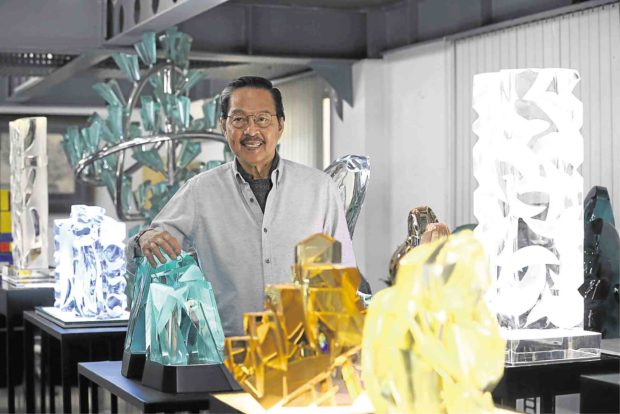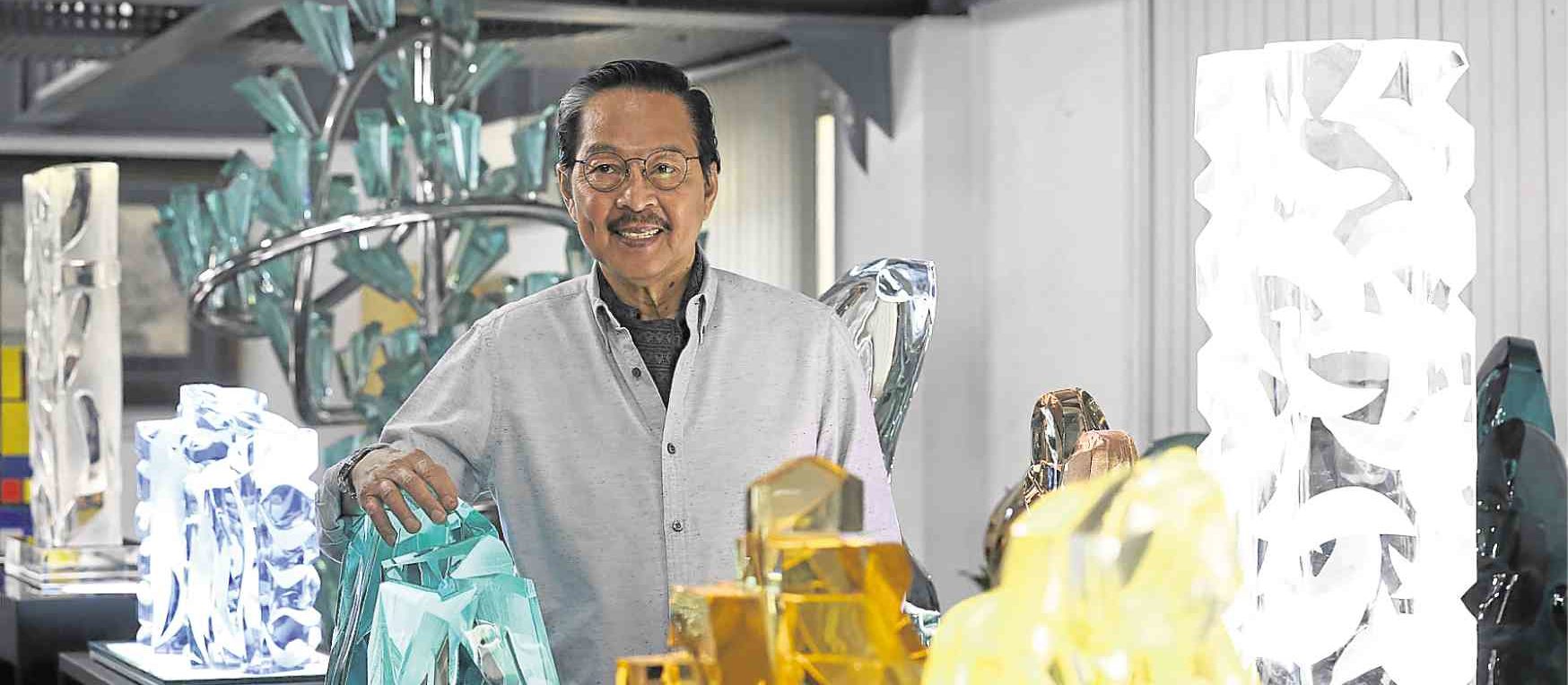
“Artists don’t retire,” says sculptor Ramon Orlina, who turns 75 this month. “As you get older, you get better.”
Although he has been working with glass, his chosen medium, for nearly 50 years now, he still finds the material endlessly fascinating.
“You have to innovate as an artist, you have to create,” he says. “If you’re not creating, you’re just repeating yourself. That’s not creation, that’s replication.”
“Some artists just repeat themselves,” he says with a shrug. “But if people buy it, what can you do?”
We are in Orlina’s cavernous atelier in an obscure corner of Balic-Balic in Sampaloc.
From the outside, it’s a nondescript building painted bright green. Inside, however, is a different story. It is a veritable beehive of activity: as many as 20 of the sculptor’s assistants are hard at work grinding, sanding and polishing the pieces that, after weeks or even months of daily handwork, will become the instantly-recognizable abstract forms and shapes that Orlina is known for. Pieces that seem to glow with an inner light.
Orlina still does the initial carving himself, the so-called “cold process” that doesn’t involve heating the material but is purely sculptural.
“Marble, glass or wood: If you want to make a horse, you remove what is not “horse.” That’s sculpture,” he says. “In direct carving, you cannot repeat yourself. Each piece is unique.”
Orlina, among Filipino artists, is sui generis. An architecture major at the University of Santo Tomas, his only exposure to art was the school’s annual art competition. There was only one gallery in Manila, he recalls, the Philippine Art Gallery in Ermita which he didn’t go to.
No formal training
“I have no formal training in art,” he says. “Nobody taught me how to do what I do. That’s something I can be proud of.”
Orlina liked to draw, however. He was inspired by his uncle, the comics illustrator Jim Fernandez (best known as the creator of Zuma).
After graduation, he started painting on sheets of glass, which caught the attention of the owners of the largest glass factory at the time. They offered Orlina a three-year art scholarship, but wary of entanglements and obligations, he refused.
Instead, he asked if he could observe the glass-making process at the factory. In particular, he was interested in the large lumps of raw glass that were a by-product of the glass-making process.
“Painting is flat—it’s two dimensional,” he says. “As an architect I was interested in three-dimensional forms. What can I use that has not been used by others before?”
At the time, glass sculpture was all but unheard of. True, there was a long tradition of glass art in Europe, but they usually involved the so-called “hot” processes which involved blowing or casting molten glass. Nobody was working with the “cold” process, which made it a natural choice for Orlina.
After creating his first pieces—which he kept under wraps for fear of other artists copying his method—Orlina was commissioned by the Silahis hotel to create a large centerpiece.
The lie
The result was “Arcanum XIX, Paradise Gained,” created in 1976. It caught the eye of Australian artist Gerry King, who wrote that it “gave the lie the popular notion that contemporary glass was a creature of Europe and North America.”
The massive sculpture, which consists of 12 discrete modules bolted together, is now on display at the National Museum of Natural History.
“I couldn’t have created it if I wasn’t an architect,” says Orlina, who used structural engineering techniques to hold the massive sculpture together. “That turned out to be a big advantage.”
Despite the success of the Silahis commission, Orlina remained largely unknown for the next 10 years.
“From 1976 to 1986, nobody knew who I was here,” he recalls. “Nobody wrote about me.”
Ironically, Orlina was better known in Singapore, where he won a number of high-profile commissions and was exhibited in the Singapore Art Museum.
Museo Orlina
Today, of course, it’s a different story. Orlina has become one of the more prominent Filipino artists, not least because he has focused almost exclusively on glass as his medium. Museo Orlina in Tagaytay City, his art museum and sculpture garden, has become a showcase for his works and a popular day-trip for families out to catch a little culture with their leisure.
Now at an age when thoughts turn to legacy, Orlina has that covered too. Youngest daughter Anna, who has studied glass art in Seattle and New York as well as the Czech Republic, looks set to follow in her father’s footsteps, and perhaps even surpass him.
“That makes me very happy,” says the sculptor, who pulls out his smartphone to show us pictures of Anna’s first glass piece.
“Frankly, she is teaching me new ideas, new techniques,” he says.














































